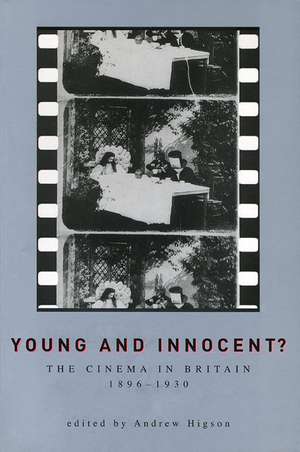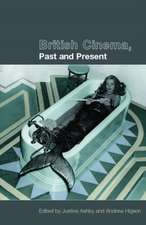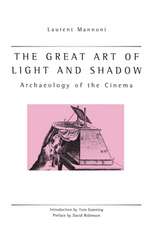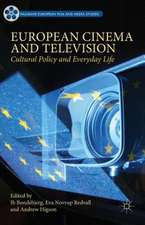Young And Innocent?: The Cinema in Britain, 1896-1930: Exeter Studies in Film History
Autor Andrew Higsonen Limba Engleză Paperback – 31 dec 2001
This book brings together the study of silent cinema and the study of British cinema, both of which have seen some of the most exciting developments in Film Studies in recent years. The result is a comprehensive survey of one of the most important periods of film history. Most of the acknowledged experts on this period are represented, joined by several new voices. Together they chart the development of cinema in Britain from its beginnings in the 1890s to the conversion to sound in the late 1920s. From these accounts the youthful British cinema emerges as far from innocent. On the contrary, it was a fascinatingly complex field of cultural and industrial practices. The book also includes guides to bibliographical and archival sources and an extensive bibliography.
Din seria Exeter Studies in Film History
- 19%
 Preț: 502.45 lei
Preț: 502.45 lei - 19%
 Preț: 500.40 lei
Preț: 500.40 lei - 19%
 Preț: 536.42 lei
Preț: 536.42 lei -
 Preț: 267.18 lei
Preț: 267.18 lei -
 Preț: 382.22 lei
Preț: 382.22 lei -
 Preț: 263.71 lei
Preț: 263.71 lei -
 Preț: 316.83 lei
Preț: 316.83 lei -
 Preț: 319.71 lei
Preț: 319.71 lei -
 Preț: 337.85 lei
Preț: 337.85 lei -
 Preț: 259.89 lei
Preț: 259.89 lei - 27%
 Preț: 851.67 lei
Preț: 851.67 lei - 27%
 Preț: 738.31 lei
Preț: 738.31 lei - 27%
 Preț: 703.97 lei
Preț: 703.97 lei - 23%
 Preț: 574.51 lei
Preț: 574.51 lei -
 Preț: 175.23 lei
Preț: 175.23 lei - 20%
 Preț: 495.09 lei
Preț: 495.09 lei - 21%
 Preț: 491.43 lei
Preț: 491.43 lei - 21%
 Preț: 490.30 lei
Preț: 490.30 lei - 21%
 Preț: 491.68 lei
Preț: 491.68 lei -
 Preț: 175.71 lei
Preț: 175.71 lei - 22%
 Preț: 481.98 lei
Preț: 481.98 lei - 21%
 Preț: 496.88 lei
Preț: 496.88 lei - 15%
 Preț: 481.57 lei
Preț: 481.57 lei
Preț: 350.03 lei
Nou
Puncte Express: 525
Preț estimativ în valută:
66.99€ • 69.68$ • 55.30£
66.99€ • 69.68$ • 55.30£
Carte tipărită la comandă
Livrare economică 14-28 aprilie
Preluare comenzi: 021 569.72.76
Specificații
ISBN-13: 9780859897174
ISBN-10: 0859897176
Pagini: 432
Ilustrații: 32 illustrations
Dimensiuni: 234 x 163 x 28 mm
Greutate: 0.74 kg
Ediția:1
Editura: UNIVERSITY OF EXETER PRESS
Colecția University of Exeter Press
Seria Exeter Studies in Film History
Locul publicării:United Kingdom
ISBN-10: 0859897176
Pagini: 432
Ilustrații: 32 illustrations
Dimensiuni: 234 x 163 x 28 mm
Greutate: 0.74 kg
Ediția:1
Editura: UNIVERSITY OF EXETER PRESS
Colecția University of Exeter Press
Seria Exeter Studies in Film History
Locul publicării:United Kingdom
Notă biografică
Andrew Higson is Professor of Film and Television at the University of York in the UK. He taught at the University of East Anglia from 1986 to 2008, where he was head of Film and Television Studies for several years. He has published widely on British cinema and on debates about national cinema. He is the author of English Heritage, English Cinema: Costume Drama Since 1980 (OUP, 2003) and Waving the Flag: Constructing a National Cinema in Britain (OUP, 1995); as editor, his books include British Cinema, Past and Present, co-edited with Justine Ashby (Routledge, 2000), and ’Film Europe’ and ‘Film America’: Cinema, Commerce and Cultural Exchange, 1920-1939, co-edited with Richard Maltby(University of Exeter Press, 1999).
Cuprins
List of Illustrations
Picture Credits
Acknowledgements
Introduction
Andrew Higson
SECTION A – Putting the Pioneers in Context: Films and Filmmakers before the First World War
1. “But the Khaki-Covered Camera is the Latest Thing”: The Boer War Cinema and Visual Culture in Britain
Simon Popple
2. James Williamson’s Rescue Narratives
Frank Gray
3. Cecil Hepworth, Alice in Wonderland and the Development of the Narrative Film
Andrew Higson
4. Putting the World before You: The Charles Urban Story
Luke McKernan
5. “It would be a Mistake to Strive for Subtlety of Effect”: Richard III and Populist, Pantomime Shakespeare in the 1910s
Jon Burrows
SECTION B – Going to the Cinema: Audiences, Exhibition and Reception from the 1890s to the 1910s
6. “Indecent Incentives to Vice”: Regulating Films and Audience Behaviour from the 1890s to the 1910s
Lise Shapiro Sanders
7. “Nothing More than a ‘Craze’”: Cinema Building in Britain from 1909 to 1914
Nicholas Hiley
8. Letters to America: A Case Study in the Exhibition and Reception of American Films in Britain, 1914-1918
Michael Hammond
SECTION C – A Full Supporting Programme: Serials, Cinemagazines, Interest Films, Travelogues and Travel Films, and Film Music in the 1910s and 1920s
9. British Series and Serials in the Silent Era
Alex Marlow-Mann
10. The Spice of the Perfect Programme: The Weekly Magazine Film during the Silent Period
Jenny Hammerton
11. Shakespeare’s Country: The National Poet, English Identity and British Silent Cinema
Roberta E. Pearson
12. Representing “African Life”: From Ethnographic Exhibitions to Nionga and Stampede
Emma Sandon
13. Distant Trumpets: The Score to The Flag Lieutenant and Music of the British Silent Cinema
Neil Brand
SECTION D – The Feature Film at Home and Abroad: Mainstream Cinema From the End of the First World War to the Coming of Sound
14. Writing Screen Plays: Stannard and Hitchcock
Charles Barr
15. H.G. Wells and British Silent Cinema: The War of the Worlds
Sylvia Hardy
16. War-Torn Dionysus: The Silent Passion of Ivor Novello
Michael Williams
17. Tackling the Big Boy of Empire: British Film in Australia, 1918-1931
Mike Walsh
SECTION E – Taking the Cinema Seriously: The Emergence of an Intellectual Film Culture in the 1920s
18. The Film Society and the Creation of an Alternative Film Culture in Britain in the 1920s
Jamie Sexton
19. Towards a Critical Practice: Ivor Montagu and British Film Culture in the 1920s
Gerry Turvey
20. Writing the Cinema into Daily Life: Iris Barry and the Emergence of British Film Criticism in the 1920s
Haidee Wasson
SECTION F – Bibliographical and Archival Resources
21. A Guide to Bibliographical and Archival Sources on British Cinema before the First World War
Stephen Bottomore
22. A Guide to Bibliographical and Archival Sources on British Cinema from the First World War to the Coming of Sound
Jon Burrows
23. Bibliography: British Cinema Before 1930
compiled by Andrew Higson, Michael Williams and Jo-Anne Blanco
Notes on Contributors
Index
Recenzii
“Two themes in particular stand out, which draw on the interdisciplinary pattern of much current early media work. One is to locate moving pictures in a wider fabric of popular culture . . . The other new and welcome trend apparent in this collection is a move away from directors and even from individual films towards a consideration of industrial issues . . . [this collection] testifies to a lively culture of research and discovery around early British cinema which is a welcome change from the self-flagellation of earlier generations.” –Sight and Sound, June 2002
“This book is both necessary, and important . . . A collection of introductory essays such as this has not before been undertaken, and it provides an invaluable reference point to students of this neglected period . . . The greatest value in the book lies in its final section, in which Steve Bottomore and Jon Burrows give a comprehensive overview of the resources available to those interested in the period . . . The silent period in Britain can be daunting, given its lack of secondary source material, but the two pieces between them provide an opening into the period to any interested party, and should be recommended reading on all film history courses. These are backed up by an impressive bibliography which is well organised, thorough and completely indispensable. There is no doubt that this is a book which every film student should have on his or her shelf . . . What comes across most is the variety of approaches available and the wealth of work yet to be done, as well as the community and the enthusiasm of the academics, archivists, students and historians who are undertaking it. The message is clear; grab a notepad and join in. There is much to do. Essential.” –Viewfinder, No. 47, June 2002













